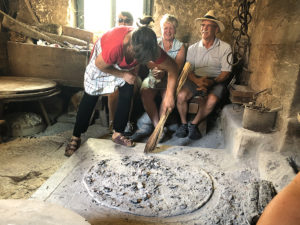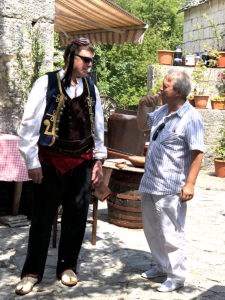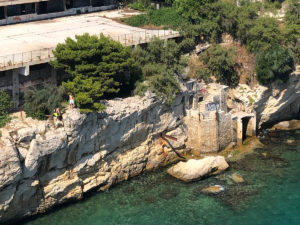Sapphire Waters, Grand City Walls
Split, Croatia
Tuesday, July 16, 2019
Poljica Republic–Life and Food
 This first thing we saw this morning was a testament to all the good things about cruises like this one. We had boarded the ship in Venice, just about as close as you can get to sea level and still be on land. The first stop had been Corsini/Ravenna, still a lot of flat land everywhere we looked. Salt marshes and flamingoes are nice and all that, but the water ism’t all that attractive, and flat is flat. But destination cruises move the ship during the night, and you know you’ll be somewhere new when you wake up. So we had last seen flat land and boring water, but this morning we had already crossed the Adriatic and BOOM: beautiful blue water, limestone cliffs, mountains close enough to practically count the trees from the pool deck, and the brightest sunrise you could ever hope for just waiting for us to smile back at it.
This first thing we saw this morning was a testament to all the good things about cruises like this one. We had boarded the ship in Venice, just about as close as you can get to sea level and still be on land. The first stop had been Corsini/Ravenna, still a lot of flat land everywhere we looked. Salt marshes and flamingoes are nice and all that, but the water ism’t all that attractive, and flat is flat. But destination cruises move the ship during the night, and you know you’ll be somewhere new when you wake up. So we had last seen flat land and boring water, but this morning we had already crossed the Adriatic and BOOM: beautiful blue water, limestone cliffs, mountains close enough to practically count the trees from the pool deck, and the brightest sunrise you could ever hope for just waiting for us to smile back at it.
 And if the beginning wasn’t enough to make the day, we soon headed out on what was probably the most fun we’ve ever had on a shore excursion! This wasn’t officially a “small group” outing, but ten of the twenty-three people who had signed up backed out before we boarded the bus. That was OK with those of us who were left, because we got a more personalized and much better experience out of the day. All fourteen of us, including Slobodon Juretič, our guide, got on a 46-passenger bus and started on the road out of town.
And if the beginning wasn’t enough to make the day, we soon headed out on what was probably the most fun we’ve ever had on a shore excursion! This wasn’t officially a “small group” outing, but ten of the twenty-three people who had signed up backed out before we boarded the bus. That was OK with those of us who were left, because we got a more personalized and much better experience out of the day. All fourteen of us, including Slobodon Juretič, our guide, got on a 46-passenger bus and started on the road out of town.
 We slowly worked our way uphill and through traffic to get out of the city. Bobo had a very easy-going way of filling us in on local history while he was pointing out interesting things to see along the way. Things like Roman aqueducts, part of Diocletian’s Palace, and a building high atop a stone outcropping that turned out to be one of the filming locations for Game of Thrones. Once we got onto the four-lane highways, some of which were toll roads, it was smooth sailing for about 40 minutes,. The day was bright and clear, and we had great views of some beautiful countryside, a good deal of it vertical; we were definitely going uphill. Pretty soon there were no tall trees of any kind to be seen on the rocky ground. And I mean Rocky Ground with capital letters. Small boulders or big rocks everywhere that wasn’t already under cultivation. Dry stone walls around some tilled field or orchards had been made as a by-product of clearing land for planting. Bobo said it’s against the law to build on already cleared land around here now. It’s too valuable for use as crop land.
We slowly worked our way uphill and through traffic to get out of the city. Bobo had a very easy-going way of filling us in on local history while he was pointing out interesting things to see along the way. Things like Roman aqueducts, part of Diocletian’s Palace, and a building high atop a stone outcropping that turned out to be one of the filming locations for Game of Thrones. Once we got onto the four-lane highways, some of which were toll roads, it was smooth sailing for about 40 minutes,. The day was bright and clear, and we had great views of some beautiful countryside, a good deal of it vertical; we were definitely going uphill. Pretty soon there were no tall trees of any kind to be seen on the rocky ground. And I mean Rocky Ground with capital letters. Small boulders or big rocks everywhere that wasn’t already under cultivation. Dry stone walls around some tilled field or orchards had been made as a by-product of clearing land for planting. Bobo said it’s against the law to build on already cleared land around here now. It’s too valuable for use as crop land.
 Once we left the freeway the roads got smaller and smaller. And twistier and twistier. Not as bad as the switchbacks we had seen the day before in San Marino, but curvy enough for flat-landers like us. In large busses. We finally reached Radoviči, a small farming community, and Bobo’s farm, which he had inherited from his grandfather some time ago. The village had once been home to about 120 people, but it has only 24 inhabitants now. Bobo started up this series of tourist visits a few years ago as a way of preserving knowledge of this kind of life for the future.
Once we left the freeway the roads got smaller and smaller. And twistier and twistier. Not as bad as the switchbacks we had seen the day before in San Marino, but curvy enough for flat-landers like us. In large busses. We finally reached Radoviči, a small farming community, and Bobo’s farm, which he had inherited from his grandfather some time ago. The village had once been home to about 120 people, but it has only 24 inhabitants now. Bobo started up this series of tourist visits a few years ago as a way of preserving knowledge of this kind of life for the future.
The farm consisted of several separate stone buildings, like the walls around fields, made from the local limestone that was everywhere around us.The oldest one, 300 years old, has very thick walls and was built for winter living. There are other buildings for cooking, livestock, storage, etc., all on about a 30-degree downhill slope. Just nuts that someone would figure out how to live there. Much less create a farming village! The landscape was beautiful, yes, but a flat-lander like me was really pretty nervous thinking about living through a winter there.
 We got off the bus and were greeted by Sofia, Bobo’s wife, who had small glasses of home-made grappa ready and waiting for us. That was strong stuff. The grappa was followed by a taste of whatever flavored brandy we wanted to try. The brandies was made, by Mrs. Bobo, by steeping nuts, fruits, herbs, what have you, in the grappa. In jugs in the sunlight for 42 days. Judy had some walnut brandy and I had anise—both very tasty! The brandies were accompanied by dried figs and carob. Chewing dried carob seed pods was a new treat for both of us.
We got off the bus and were greeted by Sofia, Bobo’s wife, who had small glasses of home-made grappa ready and waiting for us. That was strong stuff. The grappa was followed by a taste of whatever flavored brandy we wanted to try. The brandies was made, by Mrs. Bobo, by steeping nuts, fruits, herbs, what have you, in the grappa. In jugs in the sunlight for 42 days. Judy had some walnut brandy and I had anise—both very tasty! The brandies were accompanied by dried figs and carob. Chewing dried carob seed pods was a new treat for both of us.
 We then moved down into a courtyard to watch a neighbor make soparnik, a local dish that was being prepared as part of our morning snack. It was a fascinating thing to watch being done, everything from rolling out the dough, to putting a layer of chard and onion between two pieces of pastry, to cooking it with hots coals and ashes applied directly to the crust, to sweeping the ashes off and painting it with olive oil. And it was really good! The snack was made complete with some other local delicacies, things like thin slices of smoked ham, cheese, pickles, fresh vegetables, and a nice red table wine.
We then moved down into a courtyard to watch a neighbor make soparnik, a local dish that was being prepared as part of our morning snack. It was a fascinating thing to watch being done, everything from rolling out the dough, to putting a layer of chard and onion between two pieces of pastry, to cooking it with hots coals and ashes applied directly to the crust, to sweeping the ashes off and painting it with olive oil. And it was really good! The snack was made complete with some other local delicacies, things like thin slices of smoked ham, cheese, pickles, fresh vegetables, and a nice red table wine.
 While we were eating, Bobo introduced his neighbor and cousin, who wore traditional dress and played a one-stringed instrument that I later learned is a type of gusle. It was a fascinating instrument to look at. One string, made of about 30 horsehairs, skin head, carved horse (?) head scroll. He was joined by the accordion player who had played sort of in the background while the soparnik was being prepared. The cousin then sang a history song (explained by Bobo before he began) and accompanied himself on the gusle. Judy and I both took note of the limited pitches in the melody, while he played the same notes (without the vocal ornamentations) on the gusle. Listening to him almost made me regret I couldn’t tell students about hearing him in my next MU126 class. (Not really. It was just habit to think that way.)
While we were eating, Bobo introduced his neighbor and cousin, who wore traditional dress and played a one-stringed instrument that I later learned is a type of gusle. It was a fascinating instrument to look at. One string, made of about 30 horsehairs, skin head, carved horse (?) head scroll. He was joined by the accordion player who had played sort of in the background while the soparnik was being prepared. The cousin then sang a history song (explained by Bobo before he began) and accompanied himself on the gusle. Judy and I both took note of the limited pitches in the melody, while he played the same notes (without the vocal ornamentations) on the gusle. Listening to him almost made me regret I couldn’t tell students about hearing him in my next MU126 class. (Not really. It was just habit to think that way.)
After our snack and the entertainment, Bobo took us on a short tour of the place. He was very relaxed and informative about it, and he was attentive to everyone. We even met his donkey—Lily, I think. There was a white mulberry there with a split trunk that looked like a smaller version of the Cook Hill “office” tree. The tour concluded with a sit-down historical look-around at family mementoes and photographs in the oldest building on the farm. The most interesting part of that was two pieces of furniture. The first was a wall-mounted shelf with glass doors. Made in Croatia, it had been taken to the US by Slobodan’s grandfather, who then brought it back with him when he had to return to Croatia because of a bad business deal. The other piece was a chifforobe from about 1900. It had been made in the US and brought to Croatia by the returning grandfather. It looked like an Eastlake piece, the kind of thing we see a lot of in antique shops and second-hand stores.
 By the time the tour was over, lunch was ready. Veal, pork and chicken, along with some vegetables, had been cooked in large flat pans placed on the same hearth we had seen earlier. The pans had been covered with metal domes, and those had been covered with hot coals. I guess those domes meant the heat was trapped and the domes made sort of an oven for the food to cook in. A mixed salad and more local wine topped things off, and lunch was a winner.
By the time the tour was over, lunch was ready. Veal, pork and chicken, along with some vegetables, had been cooked in large flat pans placed on the same hearth we had seen earlier. The pans had been covered with metal domes, and those had been covered with hot coals. I guess those domes meant the heat was trapped and the domes made sort of an oven for the food to cook in. A mixed salad and more local wine topped things off, and lunch was a winner.
 We said goodbye to Mrs. Juretič and the neighbors somewhat reluctantly and started the ride back to port. Judy and I went to the pool deck to just chill our and enjoy the end of the day. I’m not sure how much reading we got done, because we both enjoyed watching teenagers jump off the cliff into the water. They would toss shoes—flip-flops or sandals of some kind—and swim around to put them on before they climbed out on the rocks and did it all over again. When they had all made it into the water from one level, they climbed to a higher spot and did it again. And again. The water was a clear blue, and you could see the rock face going down into the water. The whole process looked like a lot of fun.
We said goodbye to Mrs. Juretič and the neighbors somewhat reluctantly and started the ride back to port. Judy and I went to the pool deck to just chill our and enjoy the end of the day. I’m not sure how much reading we got done, because we both enjoyed watching teenagers jump off the cliff into the water. They would toss shoes—flip-flops or sandals of some kind—and swim around to put them on before they climbed out on the rocks and did it all over again. When they had all made it into the water from one level, they climbed to a higher spot and did it again. And again. The water was a clear blue, and you could see the rock face going down into the water. The whole process looked like a lot of fun.
Dinner that night was in Sette Mari, the Italian-themed restaurant that occupied the same space used for breakfast and lunch buffets. Service was good and food excellent. It was kind of fun to see an antipasto buffet and salad bar, with a well-done menu available for the rest of the meal. Once again we hit the Observation Lounge bar for a nightcap before turning in for the night.
Photos












